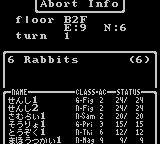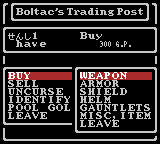Retro Replay Review
Gameplay
Wizardry: Proving Grounds of the Mad Overlord places you in control of a customizable party of up to six adventurers, each drawn from five races and four core classes. From the outset, you decide whether to field nimble elves, stout dwarves, crafty gnomes or hobbits alongside human heroes, then assign them roles as Fighters, Priests, Mages, or Thieves. This granular party creation system is the heart of the experience, as you’ll continually refine your lineup to tackle the dungeon’s escalating challenges.
(HEY YOU!! We hope you enjoy! We try not to run ads. So basically, this is a very expensive hobby running this site. Please consider joining us for updates, forums, and more. Network w/ us to make some cash or friends while retro gaming, and you can win some free retro games for posting. Okay, carry on 👍)
Once your party is assembled, the game shifts to a first-person, grid‐based dungeon crawl where every decision carries weight. Movement, exploration and combat follow strict turn-based rules, demanding careful consideration of each step. Do you push forward in search of treasure, or retreat to recuperate in town? With only limited healing options and the ever‐present risk of party wipeouts, strategic resource management becomes second nature.
Combat itself unfolds in tactical detail: you choose which spells to cast, where to position your melee fighters, and when to use precious healing supplies. Character progression adds another layer of depth—leveling unlocks new abilities, and veteran warriors can eventually evolve into elite classes like Samurai or Lord, blending martial prowess with arcane power. This steady sense of growth is highly rewarding, even if the learning curve can feel steep to newcomers.
Graphics
By modern standards, Wizardry’s visuals are minimalist: wireframe corridors and static, symbolic monster portraits represent the dungeon’s depth and dangers. There are no full‐motion animations or lavish cutscenes—what you see is rendered in crisp lines and basic color fills. Yet this simplicity allows your imagination to fill in the gaps, and the austere presentation has a certain retro charm that still resonates with fans of old-school RPGs.
Monster encounters are introduced via straightforward illustrations that change as you move closer, while spell effects are indicated by simple iconography and text prompts. Though primitive next to today’s AAA titles, these graphics effectively convey vital information without distracting flourishes. They emphasize gameplay and atmosphere over flashy visuals, making every narrow hallway and sudden ambush feel tense and essential.
On modern platforms or through emulated ports, the clean, grid‐based view scales neatly to larger screens. Fan‐made texture packs and quality‐of‐life mods can add color and styling, but the core aesthetic remains faithful to the original. If you appreciate the roots of dungeon‐crawling and can look past pixel‐era limitations, Wizardry’s graphics serve their purpose with clarity and nostalgic appeal.
Story
The narrative premise sets the stage for your adventure: Trebor, the once merely power‐hungry Mad Overlord, plunged into madness after obtaining a potent magical amulet. His rival, the archmage Werdna, stole this artifact only to unleash an earthquake that carved out a ten‐level labyrinth beneath Trebor’s fortress. To save face, Werdna claimed the dungeon as his lair, teeming with monsters, while Trebor declared it the “Proving Grounds” for those daring enough to seek his amulet’s return.
While the story is delivered mostly through brief text interludes and sparse descriptions, it provides clear motivation for exploration and conflict. There’s no twisting plot or fully voiced dialogue—rather, you piece together the lore as you delve deeper, uncovering notes, magical scrolls, and the inevitable showdown with Werdna himself. This stripped‐down storytelling aligns with the game’s old‐school ethos, encouraging players to imagine the rest.
As you progress through the Proving Grounds, the sense of urgency grows: Trebor demands proof of your worthiness, and each monster hoard you defeat brings you closer to reclaiming the amulet. The story may not rival modern RPG epics in complexity, but its straightforward premise—retrieve the artifact, overcome the mad archmage—delivers a satisfying framework for the challenging gameplay.
Overall Experience
Wizardry: Proving Grounds of the Mad Overlord stands as a pillar of the dungeon‐crawl genre, its influence evident in countless successors. Playing it today is an exercise in patience and perseverance—mapping the maze by hand, managing scarce resources, and navigating unforgiving combat. For veteran RPG enthusiasts, this is a welcome throwback to a time when attention to detail and methodical play were rewarded.
Newcomers should be prepared for a steep learning curve. The lack of hand‐holding, the need for manual mapping and the danger of permanent character death can feel brutal compared to contemporary design conventions. However, overcoming these hurdles brings a deep sense of accomplishment, and every level gained or treasure found feels genuinely earned.
Ultimately, if you value challenging gameplay, party‐based customization and the satisfaction of mastering a classic system, Wizardry: Proving Grounds of the Mad Overlord offers a timeless experience. Its austere graphics and sparse storytelling may not appeal to everyone, but for those seeking the roots of Western RPGs and a true old‐school adventure, this dungeon crawler remains an essential journey.
 Retro Replay Retro Replay gaming reviews, news, emulation, geek stuff and more!
Retro Replay Retro Replay gaming reviews, news, emulation, geek stuff and more!









Reviews
There are no reviews yet.